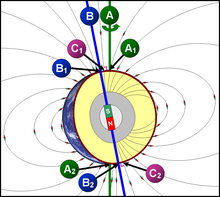지리극

지리극은 회전축이 표면과 교차하는 두 점들 가운데 하나이다.[1] 북극점은 북극해에 놓이며 남극점은 남극에 놓인다. 북극과 남극은 태양계의 다른 행성이나 위성에도 정의되기도 하며 이때 북극면은 지구의 북극과 동일한 불변면이 된다.[2]
지구 표면에 상대적으로 지리극은 수년에 걸쳐 수미터 이동한다.[3]
각주[편집]
- ↑ Kotlyakov, Vladimir; Komarova, Anna (2006). 〈pole; geographic pole〉. 《Elsevier's dictionary of geography : in English, Russian, French, Spanish and German》 1판. Elsevier. 557쪽. ISBN 9780080488783. 2015년 6월 22일에 확인함.
- ↑ Archinal, B. A.; A’Hearn, M. F.; Bowell, E.; Conrad, A.; Consolmagno, G. J.; Courtin, R.; Fukushima, T.; Hestroffer, D.; Hilton, J. L.; Krasinsky, G. A.; Neumann, G.; Oberst, J.; Seidelmann, P. K.; Stooke, P.; Tholen, D. J.; Thomas, P. C.; Williams, I. P. (February 2011). “Report of the IAU Working Group on Cartographic Coordinates and Rotational Elements: 2009”. 《Celestial Mechanics and Dynamical Astronomy》 109 (2): 101–135. doi:10.1007/s10569-010-9320-4.
- ↑ Lovett, Richard A. (2013년 5월 14일). “Climate change has shifted the locations of Earth's North and South Poles”. Scientific American. 2019년 1월 6일에 확인함.
